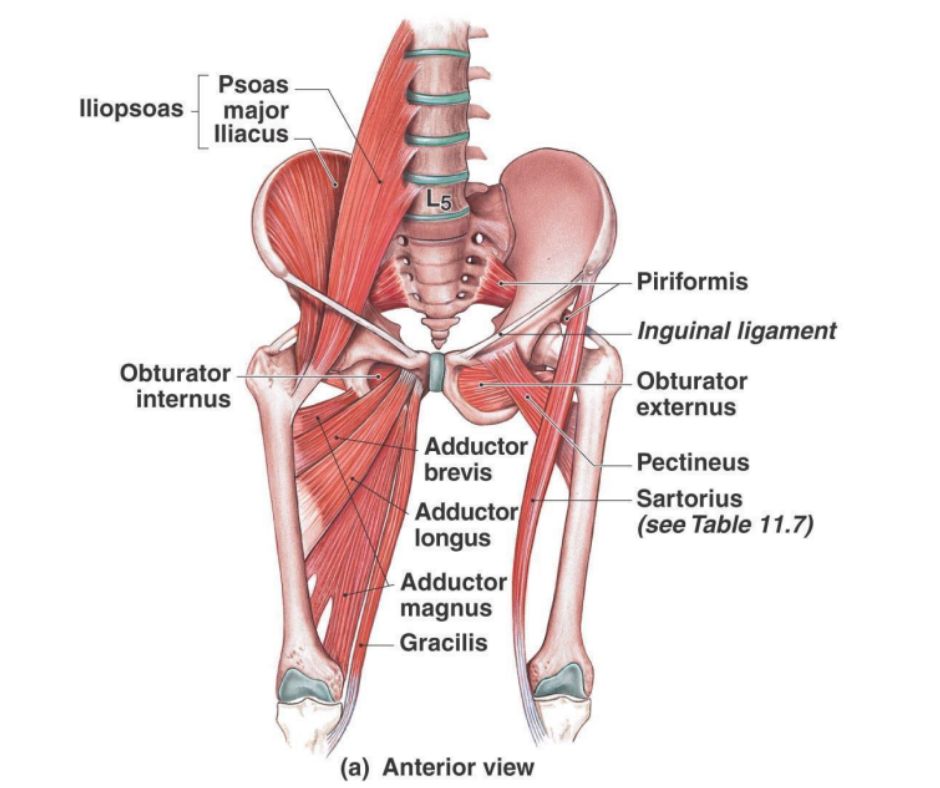Hip bursitis, also known as gluteal tendinopathy or trochanteric bursitis, is a condition characterized by pain on the outside of the hip, specifically in the region where the hip bone (trochanter) and the gluteal muscles attach.
The condition is defined by inflammation and pain in the bursa of the hip joint. The bursa is a fluid-filled sac that acts as a cushion between bone and soft tissue. It is a common cause of hip pain in adults and is more common in women than in men.
In the hip joint, there are two bursae: the trochanteric bursa and the iliopsoas bursa. Trochanteric bursitis, also known as greater trochanteric pain syndrome, is the most common form of hip bursitis.
 The main muscles involved in hip bursitis include the gluteus medius, maximus, and minimus, which are located on the side of the hip, and the tensor fasciae latae, which is a small muscle that connects to the iliotibial band.
The main muscles involved in hip bursitis include the gluteus medius, maximus, and minimus, which are located on the side of the hip, and the tensor fasciae latae, which is a small muscle that connects to the iliotibial band.
The gluteus maximus is the largest muscle in the buttocks and is responsible for extending the hip. The gluteus medius and minimus are smaller muscles that are located on the side of the hip and are responsible for abduction and stabilization of the hip joint.
These muscles work together to stabilize the hip joint during walking and other movements. When these muscles are overused or injured, it can lead to inflammation and irritation of the bursa, causing pain and discomfort.
There are a number of tendons involved in hip bursitis, including the gluteus maximus tendon, gluteus medius tendon, and iliotibial (IT) band. The gluteus maximus and medius tendons attach to the hip bone and can become inflamed and painful with overuse or injury as can the IT band.
 There are several possible causes of hip bursitis, including overuse or repetitive motions, such as running or biking, direct trauma to the hip, tight hip muscles, and poor biomechanics during movement.
There are several possible causes of hip bursitis, including overuse or repetitive motions, such as running or biking, direct trauma to the hip, tight hip muscles, and poor biomechanics during movement.
Other contributing factors may include arthritis, previous hip surgery, muscle weakness, imbalances and obesity.
Treatment for hip bursitis typically involves a combination of rest, ice, and anti-inflammatory medications to reduce pain and inflammation.
Exercises that focus on strengthening the gluteal muscles and improving hip mechanics can be helpful in reducing pain and improving function. Stretching and foam rolling can also be useful in reducing muscle tightness and improving flexibility.
Osteopathic treatment can be beneficial in the management of hip bursitis. An osteopath can help by performing manual therapies to release muscle tension and improve joint mobility.
They can perform a thorough evaluation to identify any underlying biomechanical issues and provide hands-on treatment to address any restrictions or imbalances. This may include soft tissue techniques, joint mobilization, and manipulation to improve joint range of motion and reduce pain.
Some exercises that may be helpful in managing hip bursitis include hip abductor and external rotator strengthening exercises, as well as stretching exercises for the hip flexors and iliotibial band.
It is important to work with a physical therapist or healthcare provider to develop a personalized exercise plan that takes into account any underlying conditions or injuries.
One type of exercise that is often found to be helpful is isometric exercise. Isometric exercises are a type of strength training exercise where the muscle contracts without changing length.
These exercises can be particularly helpful for individuals with hip bursitis or gluteal tendinopathy because they can strengthen the muscles without causing additional irritation to the inflamed bursa or tendons.
A few examples of isometric exercises include:
Side-lying hip abduction hold
Lie on your side with your bottom leg bent and your top leg straight. Lift your top leg up towards the ceiling as high as you can, then hold for 30-60 seconds before lowering it back down. Repeat for 3-5 holds on each side.
Wall sit
Stand with your back against a wall and your feet shoulder-width apart. Slowly slide down the wall until your thighs are parallel to the ground, then hold for 30-60 seconds before standing back up. Repeat for 3-5 holds.
Glute bridge hold
Lie on your back with your knees bent and feet flat on the floor. Lift your hips up towards the ceiling as high as you can, then hold for 30-60 seconds before lowering back down. Repeat for 3-5 holds.
These exercises should be performed with the guidance of a healthcare professional, such as a physical therapist or personal trainer, to ensure proper form and technique. They can be used in conjunction with other exercises and treatments.
If you suspect you are suffering from hip bursitis, you should first visit your doctor to get a diagnosis and come up with a treatment plan which can include medication, rest, physical therapy and regular sessions with an osteopath.
